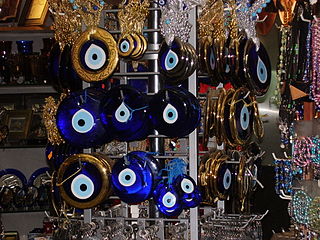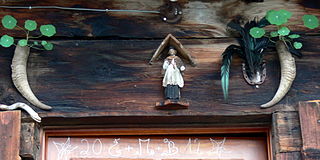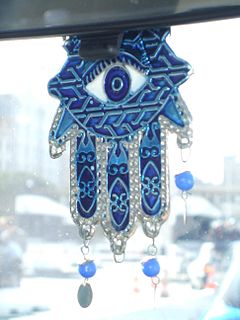Mojo, in the African-American spiritual practice called Hoodoo, is an amulet consisting of a flannel bag containing one or more magical items. It is a "prayer in a bag", or a spell that can be carried with or on the host's body. Alternative American names for the mojo bag include gris-gris bag, hand, mojo hand, conjure hand, lucky hand, conjure bag, trick bag, tricken bag, root bag, toby and jomo. The making of mojo bags in Hoodoo is a system of African-American occult magic. The creation of mojo bags is an esoteric system that involves sometimes housing spirits inside of bags for either protection, healing, or harm and to consult with spirits. Other times mojo bags are created to manifest results in a person's life such as good-luck, money or love.

Witchcraft traditionally means the use of magic or supernatural powers to harm others. A practitioner is a witch. In medieval and early modern Europe, where the term originated, accused witches were usually women who were believed to have attacked their own community, and often to have communed with evil beings. It was thought witchcraft could be thwarted by protective magic or counter-magic, which could be provided by cunning folk or folk healers. Suspected witches were also intimidated, banished, attacked or killed. Often they would be formally prosecuted and punished, if found guilty or simply believed to be guilty. European witch-hunts and witch trials in the early modern period led to tens of thousands of executions. In some regions, many of those accused of witchcraft were folk healers or midwives. European belief in witchcraft gradually dwindled during and after the Age of Enlightenment.

A curse is any expressed wish that some form of adversity or misfortune will befall or attach to one or more persons, a place, or an object. In particular, "curse" may refer to such a wish or pronouncement made effective by a supernatural or spiritual power, such as a god or gods, a spirit, or a natural force, or else as a kind of spell by magic or witchcraft; in the latter sense, a curse can also be called a hex or a jinx. In many belief systems, the curse itself is considered to have some causative force in the result. To reverse or eliminate a curse is sometimes called "removal" or "breaking", as the spell has to be dispelled, and often requires elaborate rituals or prayers.

The evil eye is a supernatural belief in a curse, brought about by a malevolent glare, usually given to a person when one is unaware. The evil eye dates back about 5,000 years. The earliest known belief in the power of the evil eye predates ancient Roman and Greek times, with literature mentioning that in the 6th century BC it appeared on Chalcidian drinking vessels, known as 'eye-cups', as a type of apotropaic magic. It is found in many cultures in the Mediterranean region as well as Western Asia and Central Asia with such cultures often believing that receiving the evil eye will cause misfortune or injury, while others believe it to be a kind of supernatural force that casts or reflects a malevolent gaze back-upon those who wish harm upon others. Older iterations of the symbol were often made of ceramic or clay; however, following the production of glass beads in the Mediterranean region in approximately 1500 BC, evil eye beads were popularised with the Phoenicians, Persians, Greeks, Romans and Ottomans.
Theatrical superstitions are superstitions particular to actors or the theatre.

Filipino witches are the users of black magic and related practices from the Philippines. They include a variety of different kinds of people with differing occupations and cultural connotations which depend on the ethnic group they are associated with. They are completely different from the Western notion of what a witch is, as each ethnic group has their own definition and practices attributed to witches. The curses and other magics of witches are often blocked, countered, cured, or lifted by Filipino shamans associated with the indigenous Philippine folk religions.

In some cultures, the foot of a rabbit is carried as an amulet believed to bring good luck. This belief is held by individuals in a great number of places around the world, including Europe, China, Africa, and North and South America. In variations of this superstition, the donor rabbit must possess certain attributes, such as having been killed in a particular place, using a particular method, or by a person possessing particular attributes.

Apotropaic magic or protective magic is a type of magic intended to turn away harm or evil influences, as in deflecting misfortune or averting the evil eye. Apotropaic observances may also be practiced out of superstition or out of tradition, as in good luck charms, amulets, or gestures such as crossed fingers or knocking on wood. Many different objects and charms were used for protection throughout history.

Exorcism is the religious or spiritual practice of evicting demons, jinns, or other malevolent spiritual entities from a person, or an area, that is believed to be possessed. Depending on the spiritual beliefs of the exorcist, this may be done by causing the entity to swear an oath, performing an elaborate ritual, or simply by commanding it to depart in the name of a higher power. The practice is ancient and part of the belief system of many cultures and religions.

Russian traditions, superstitions and beliefs include superstitions and customs of Russians. Many of them are now inseparable parts of everyday life, or simply common social etiquette, though they often have their origins in superstition. Awareness of them, and their perceived importance, depends on various factors including region and age. Some are extremely common and practiced by the vast majority of the population, while some are extremely obscure and could be more regional.

In classical antiquity, including the Hellenistic world of ancient Greece and ancient Rome, historians and archaeologists view the public and private rituals associated with religion as part of everyday life. Examples of this phenomenon are found in the various state and cult temples, Jewish synagogues, and churches. These were important hubs for ancient peoples, representing a connection between the heavenly realms and the earthly planes. This context of magic has become an academic study, especially in the last twenty years.

The hamsa is a palm-shaped amulet popular throughout North Africa and in the Middle East and commonly used in jewellery and wall hangings. Depicting the open right hand, an image recognized and used as a sign of protection in many times throughout history, the hamsa has been traditionally believed to provide defense against the evil eye.

A superstition is any belief or practice considered by non-practitioners to be irrational or supernatural, attributed to fate or magic, perceived supernatural influence, or fear of that which is unknown. It is commonly applied to beliefs and practices surrounding luck, amulets, astrology, fortune telling, spirits, and certain paranormal entities, particularly the belief that future events can be foretold by specific (apparently) unrelated prior events.

A superstition in Western cultures holds that spilling salt is an evil omen. However, salt has had a variety of meanings in religions around the world.
Superstition in Pakistan is widespread and many adverse events are attributed to the supernatural effect. Superstition is a belief in supernatural causality: that one event leads to the cause of another without any physical process linking the two events, such as astrology, omens, witchcraft, etc., that contradicts natural science. In Pakistan, the Magical thinking pervades as many acts and events are attributed to supernatural and ritual, such as prayer, sacrifice, or the observance of a taboo are followed. Many believe that magic is effective psychologically as it has placebo effect to psychosomatic diseases. Scholars of Islam view superstition as shirk, denying the unity of God and against Sharia. Within Islam, shirk is an unforgivable crime; God may forgive any sins if one dies in that state except for committing shirk. Sleeping on your right side and reciting the Ayat-ul-Kursi of the Quran can protect person from the evil.
Superstition refers to any belief or practice that is caused by supernatural causality, and which contradicts modern science. Superstitious beliefs and practices often vary from one person to another or from one culture to another.
Superstition is an excessively credulous belief in supernatural causality: the belief that one event is the cause of another without any physical process linking the two, such as astrology, omens, witchcraft, and apotropaic magic. According to Rashid Shaz the whole Muslim world is permeated with pre-Islamic superstitions, which he relates to "clinging to false hope" and even shirk.

Folk horror is a subgenre of horror film for cinema or television that uses elements of folklore to invoke fear in its audience. Typical elements include a rural setting and themes of isolation, religion, the power of nature, and sinister rural landscapes. Although related to supernatural horror films, many derive their horror from the actions and beliefs of people rather than explicitly supernatural elements; the primary focus of the stories is often upon naïve outsiders coming up against these forces.
Superstitions have been present in Britain throughout its history. Early modern Britain was a superstitious society, and the superstitions were documented at the time. The belief in witches, the devil, ghosts, apparitions, and magical healing was founded on superstitions. In modern Britain, according to a 2003 survey carried out during the National Science Week and a 2007 poll conducted by Ipsos and Ben Schott of Schott's Almanac, knocking on wood is the most popular superstition in Britain, with "crossing fingers for good luck" coming after it.












